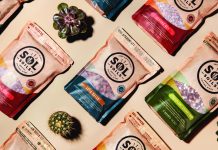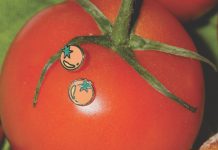
Courtesy BLNCD
In the last year, cannabidiol (CBD)—a non-psychoactive cannabinoid found in marijuana—has become one of the trendiest ingredients across all industries. Breweries are putting it in their beers (yes, even a Minnesota brewery tried it out), coffee shops like Cosmic Bean Dispensary in Dinkytown are adding it to their drinks, and makeup, skincare, and wellness product lines are including it in their formulas.
Some of the products are definitely out there, like Recess, a sparkling CBD water. However, people’s personal experiences with CBD products—and CBD’s growing acceptance in mainstream culture—are quickly selling people on the compound. According to data firm Nielsen, CBD sales are forecasted to pass $6 billion by 2025. And, for the first time, the U.S. government announced last month that it would finally spend money ($3 million, in fact) researching CBD and its touted medical properties.
With so many new products, opinions, and news surrounding the ingredient, I decided to do some of my own experimenting. But before I get into my opinions about the products I tried, let’s talk about what CBD is and why it blew up last year.
No, CBD Is Not Going to Get You High
It’s important to get this out of the way first: CBD is not going to give you a high. CBD is one of many cannabinoids derived from the cannabis family. It is non-hallucinogenic and non-psychoactive, unlike its unruly cousin THC (tetrahydrocannabinol), the primary psychoactive element found in marijuana. Bottom line? CBD won’t cause you to fail a drug test (which only tests for THC levels), and it will not make you feel intoxicated in any way. The big selling point for CBD is that it claims to contain all of the positive effects of marijuana with none of the psychoactive drawbacks.
Still, CBD’s link to marijuana has caused people to associate the chemical with the demonization of Reefer Madness. Over the years, the negative knee-jerk reaction has faded with the help of changing views about marijuana among Americans and recent legislature such as the Agriculture Improvement Act of 2018, more popularly known as the 2018 Farm Bill.
Up until the 2018 Farm Bill passed, CBD (referred to as hemp in the bill) was categorized as a Schedule I substance under the Controlled Substances Act even though it doesn’t create any psychoactive effects. This puts it on the same list as marijuana and highly addictive and dangerous narcotics like heroin. As such, it was federally illegal to cultivate, possess, or distribute hemp, from which CBD is derived.
With the passed bill, CBD that contains no more than 0.3 percent THC is officially legal at the federal level, but the Food and Drug Administration (FDA) has yet to enact research that can verify CBD’s possible mental or physical benefits. (As the FDA sees it, because of the claims that CBD can prevent and treat disease, it should be subjected to the same regulation as drugs.)
For the time being, any consumer products derived from or containing cannabis must include an FDA disclaimer, required by the Federal Food, Drug, and Cosmetic Act, with verbiage to the effect of “this product does not claim to prevent, diagnose, treat, or cure serious diseases.”
Calculating the Hype
The trend of CBD has outpaced concrete medical and scientific research and FDA regulation, but it doesn’t mean CBD should be avoided or automatically considered a hoax. Some of the limited research out there suggests that CBD is effective and beneficial for a variety of ailments, and we can only hope that more research will be supportive as well.
Among other things, CBD is touted for helping with health issues like childhood epilepsy syndromes (the FDA actually approved one form of CBD as a treatment for Lennox-Gastaut and Dravet syndromes), insomnia, chronic pain, and anxiety. The human body itself actually has an endocannabinoid system (ECS). It’s still under preliminary research, but the ECS appears to exist to receive and translate signals from cannabinoids. It even produces some cannabinoids of its own, called endocannabinoids, which help regulate functions such as sleep, immune-system responses, appetite, social behavior, anxiety, and pain.
As someone who experiences anxiety and chronic sleep issues, I’ve been interested to see if CBD actually works for me for some time now. If you’re interested in trying it for yourself, here are three brands I tried and loved:
CBD Products Worth a Shot
Kush Queen
Weirdly enough, my first encounter with CBD was in the form of a bath bomb. Conventional? Not really. It is creative, though. I am a marketing department’s dream consumer—I will fall for aesthetically pleasing Instagram accounts and pretty packaging every time. I got my first CBD bath bomb from Kush Queen, an online shop that offers everything from ingestibles (like gummies and tinctures) to topicals like its Defynt CBD Skin Serum. To start, I went for its highly rated Relax CBD Bath Bomb, which has a blend of lavender, chamomile, and frankincense plus 25 mg of CBD.
I’ve tried many kinds of bath bombs in my short 23-year-old life, but this one takes the cake. It felt like a hug, and I left the bath feeling calmer, more grounded, and softer besides. I’ve definitely felt greasy with other CBD bath bombs I’ve tried more recently, but Kush Queen’s never leave any unwanted residue. Even more popular than the Relax bath bomb is the Relieve bath bomb, which reviewers say works wonders for deep tissue pain, back pain, and body tension.
BLNCD
Locally made and tested and women-owned, BLNCD was gracious enough to provide me with a few products to try, including its luxury body oil and lotion, and its Bliss CBD oil tincture. The jury is still out on the Bliss oil tincture for me because I haven’t managed to make it a daily morning habit, which in turn makes me feel like I shouldn’t give an opinion on its effectiveness. Even so, I was pleasantly surprised with how it tasted. For best effect, experts say to place the oil under the tongue and wait 60 seconds before swallowing. It was very easy to consume and didn’t coat my mouth the way I thought it would.
The BLNCD luxury body oil and lotion completely won me over. My skin tends to get very dry and irritated regardless of the season or how much lotion I use. I do not have that issue when I use these two products. The oil especially hydrates and heals, and I found myself sleeping better if I used it before bedtime. It’s truly a spa-like experience in the comfort of your own home. The smell can be slightly overpowering at first (my roommate Kelly told me I smelled strongly of essential oil with whiffs of hemp so take that as you will) but if you use in the evening, it shouldn’t be an issue at all.

Photo Credit Katie Ballalatak
The Good Patch
There are five ways to consume CBD—two are oral, one is through inhalation, and two are through the skin, including via patches. Unlike lotions or oils, which only work on the top three layers of skin, transdermal patches let CBD cross through the skin barrier and enter the bloodstream, allowing for small releases over an extended period of time. I tried two from the Good Patch, a product of La Mend. The Good Patch collection includes patches for sleeping, period pains, pain relief, hot flashes, and even hangovers. I tried the Nite Nite patch with melatonin and the Be Calm patch with menthol, both of which have 15 mg of CBD and last for 12 hours.
I was not super impressed with the sleep patch—I woke up my normal 2-3 times throughout the night—but I was pleasantly surprised by the Be Calm patch. I waited to use it until I had an abnormally anxiety-ridden day, and I noticed a difference within the hour. My thoughts didn’t race so quickly, and my body didn’t feel as tense, either. These may, of course, be consequences of other actions, such as grounding techniques, breathing exercises, and the placebo effect, but I thought the patch made it easier to stay focused and grounded.






